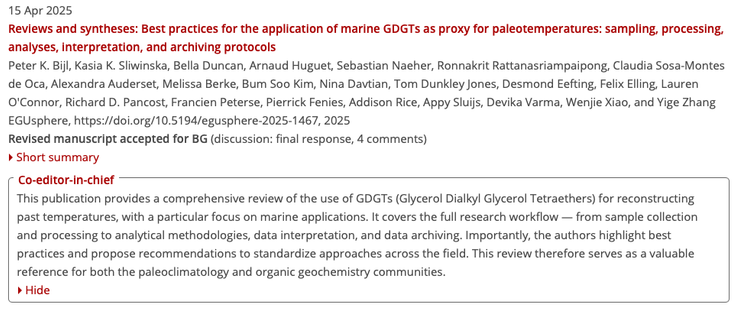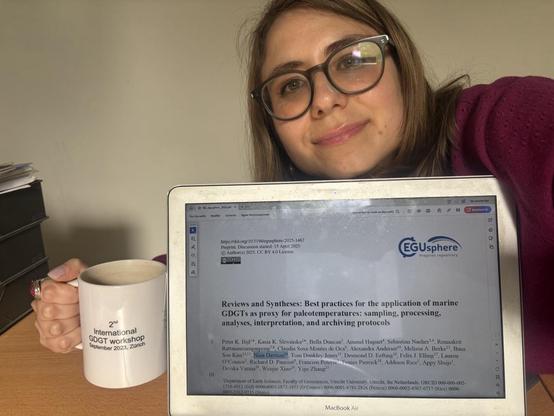As we* hoped, my co-authored #marine GDGT « cookbook » #review #paper (https://doi.org/10.5194/egusphere-2025-1467) was accepted for publication in the @EuroGeosciences #journal #Biogeosciences after peer-review and (minor) revision! 🥳 🍾
*Peter Bijl, Kasia Sliwinska, and all co-authors, including myself.
#Science
#ScienceMastodon
#AcademicMastodon
#PaperAccepted
#GDGTs #isoGDGTs #brGDGTs #TeamArchaea #TeamBacteria
#archaeal #bacterial #tetraether #lipids
#archaeal
Four weeks ago, my first co-authored @EuroGeosciences #preprint « #Reviews and syntheses: Best practices for the application of #marine #GDGTs as proxy for paleotemperatures: sampling, processing, analyses, interpretation, and archiving protocols » went online!
https://doi.org/10.5194/egusphere-2025-1467
#Science #ScienceMastodon #AcademicMastodon
#Review #Consensus
#EGUsphere
#isoGDGTs #brGDGTs #TeamArchaea #TeamBacteria
#archaeal #bacterial #tetraether #lipids
(1/2)
The last #scientific #publication from Devika Varma’s #PhD #thesis at @NIOZnieuws (https://www.nioz.nl/en/news/investigating-paleotemperature-proxies-based-on-archaeal-hydroxylated-tetraether-lipids) is now published in #OrganicGeochemistry:
https://doi.org/10.1016/j.orggeochem.2025.105010
Many thanks to Isla Castañeda for the invitation to review this paper—yes, I signed the review report.
#Science #ScienceMastodon #AcademicMastodon
#GDGTs #isoGDGTs #TeamArchaea
#Archaeal #tetraether #lipids
On this #InternationalWomensDay, let me highlight two #WomenInSTEM.
First, Amy Cromartie, who leads the following @EuroGeosciences #preprint:
https://egusphere.copernicus.org/preprints/2025/egusphere-2025-526/
Second, Devika Varma, who recently defended her #PhD #thesis. Her PhD work at @NIOZnieuws aimed to investigate #paleotemperature indicators based on #archaeal hydroxylated #tetraether #lipids (OH-isoGDGTs):
https://www.nioz.nl/en/news/investigating-paleotemperature-proxies-based-on-archaeal-hydroxylated-tetraether-lipids
#IWD #IWD25 #IWD2025
#Science #ScienceMastodon #AcademicMastodon
#GDGTs #brGDGTs #isoGDGTs
(1/3)
Announcement of #BactoGre 27 May - #bacteriology in #Grenoble meeting of #microbiologists focusing on #bacterial and #archaeal organisms and communities.
Registration is free but mandatory
https://forms.gle/nDi25ogQbdBP3yvQ7
submissions close 25 April,
registration 16 May
Invited speakers:
#CatherineLarose, "Institut des Géosciences de l’Environnement", Grenoble
#SamMeyer, "Microbiologie, Adaptation et Pathogénie", Lyon
Organisers: Sylvie Elsen, Pierre Marcoux and Sophie Abby
Contrary to current orthodoxy, #archaeal #membrane mimics are more permeable to core metabolites than #bacterial #lipid membrane mimics, informing some of the earliest transitions in cell evolution @Ula_Lapinska @AncestralState @PagliaraExeter #PLOSBiology https://plos.io/3Kxa15c
Contrary to current orthodoxy, #archaeal #membrane mimics are more permeable to core metabolites than #bacterial #lipid membrane mimics, informing some of the earliest transitions in cell evolution @Ula_Lapinska @AncestralState @PagliaraExeter #PLOSBiology https://plos.io/3Kxa15c
Contrary to current orthodoxy, #archaeal #membrane mimics are more permeable to core metabolites than #bacterial #lipid membrane mimics, informing some of the earliest transitions in cell evolution @Ula_Lapinska @AncestralState @PagliaraExeter #PLOSBiology https://plos.io/3Kxa15c
Tandem repeats in giant #archaeal #Borg elements undergo rapid #evolution and create new intrinsically disordered regions in #proteins | PLOS #Biology
Parks DH, Chuvochina M, Rinke C, et al (2022) GTDB: an ongoing census of #bacterial and #archaeal #diversity through a phylogenetically consistent, rank normalized and complete genome-based taxonomy. Nucleic Acids Research 50:D785–D794. https://doi.org/10.1093/nar/gkab776
#eukaryotes Story of its #Archaeal Ancestry |. The traditional grouping of life forms into #prokaryotes and eukaryotes was revised in 1977 when rRNA sequence characterisation revealed that #archaea (then called ‘archaebacteria’) are ‘‘as distantly related to #bacteria as bacteria are to eukaryotes.‘’ T....
https://www.scientificeuropean.co.uk/sciences/biology/eukaryotes-story-of-its-archaeal-ancestry/
#Metagenomics exploration of the diversity of #archaeal #viruses in the human gut.
New research in Nature Communication on:
New #cryoET structure from LSI Exeter colleagues Matthew Gaines et al. Bertram Daum lab, this time of the enigmatic #archaeal filament called 'thread'.
What I find cool about this work is that first they had the structure, then found the sequence based on glycosylation sites and bulky residues.
This #protein was also so ultra-stable, that resisted trypsinisation, so mass spec was not an option to identify it.
https://www.ncbi.nlm.nih.gov/pmc/articles/PMC9715654/

